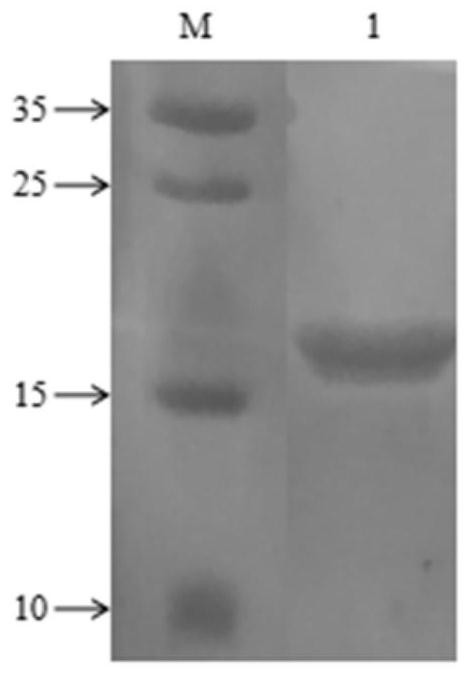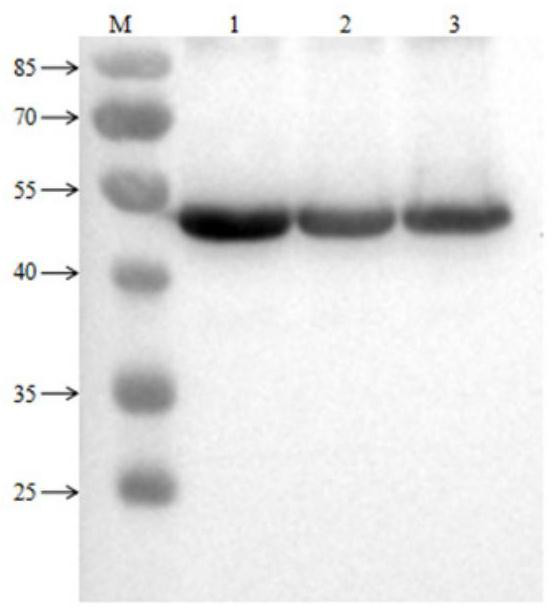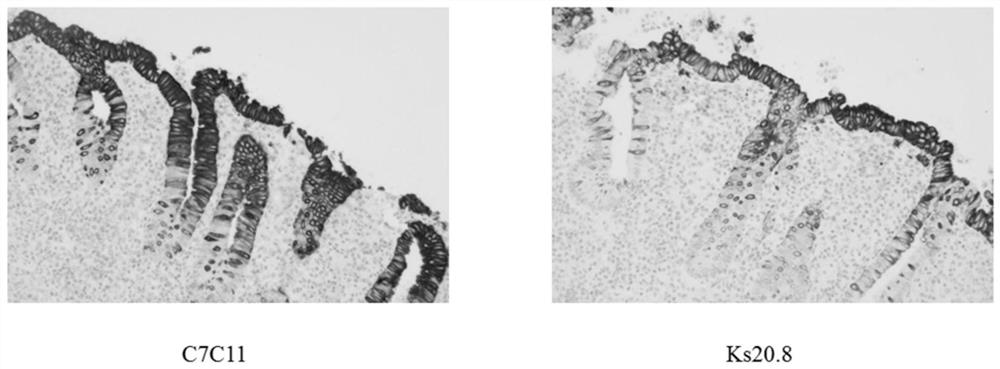CK20 antigen, hybridoma cell strain, monoclonal antibody, and application thereof
A monoclonal antibody, CK20 technology, applied in the field of immunology, can solve the problems of increasing monoclonal cell line screening, affecting judgment and diagnosis, and low specificity antibodies, so as to avoid non-specific antibodies, good accuracy and strong specificity Effect
- Summary
- Abstract
- Description
- Claims
- Application Information
AI Technical Summary
Problems solved by technology
Method used
Image
Examples
Embodiment 1
[0034] The CK20 antigen in this example is a fusion protein obtained by adding linking elements between the head and tail fragments of human CK20 protein.
[0035] The Uniprot accession number of human CK20 is P35900, which contains 424 amino acids, of which 1-69 is the head, 70-377 is the stem, and 378-424 is the tail. The amino acid and nucleotide sequence of the head is shown in SEQ ID For NO: 1 and SEQ ID NO: 2, see SEQ ID NO: 3 and SEQ ID NO: 4 for the amino acid and nucleotide sequences of the tail. According to the CK20 sequence and structure published by Uniprot, the head and tail sequences were selected as the first sequence and the second sequence, respectively.
[0036] The commonly used elastic linker (GGGGS)n is (GGGGS)n, and the elastic linker will not affect the conformation and function of the proteins at both ends. In order to ensure the distance between the head and tail of cytokeratin, reduce the steric hindrance of the head and tail, and exert the function...
Embodiment 2
[0042] The CK20 antigen in this example is artificially synthesized by adding the nucleic acid sequence SEQ ID NO: 6 of the connecting element between the head nucleotide sequence SEQ ID NO: 2 and the tail nucleotide sequence SEQ ID NO: 4 of CK20 After cloning into the pET-28a expression vector, the pET-28a-CK20-Linker expression vector was constructed and transformed into Escherichia coli to express and purify.
[0043] 1) Add the linker nucleic acid sequence between the head and tail nucleic acid sequences of CK20 for artificial synthesis, and introduce restriction sites NdeI and XhoI at both ends of the sequence, clone into the pET-28a expression vector after synthesis, and construct pET-28a - CK20-Linker expression vector.
[0044] 2) Transform the recombinant plasmid constructed above into BL21(DE3) Escherichia coli competent, pick a single colony and culture it in 4 mL of LB liquid medium containing kanamycin (50 μg / mL), add IPTG at a final concentration of 1 mM for For...
Embodiment 3
[0049] The hybridoma cell line C7C11 in the present embodiment is made by the method comprising the following steps:
[0050] 1) Animal immunization: the above-mentioned purified CK20-Linker protein was mixed with an equal volume of Freund's complete adjuvant, and the 6-8 week-old BalB / c mice were immunized by subcutaneous injection. The immunization dose was 100 μg / mouse, and two weeks later For the second immunization, the antigen was emulsified with Freund's incomplete adjuvant, and the immunization dose was the same as the first time, and intraperitoneal injection was adopted. After the second immunization, the tail blood was taken to determine the serum titer by gradient dilution by indirect ELISA method, and the mice with the highest antibody titer were selected for tail vein pulse immunization, and the pulse dose was 50 μg / mouse. .
[0051] 2) Cell fusion: the myeloma cells were sp2 / 0 derived from BalB / c, and they were in the logarithmic growth phase during fusion; the...
PUM
 Login to View More
Login to View More Abstract
Description
Claims
Application Information
 Login to View More
Login to View More - R&D
- Intellectual Property
- Life Sciences
- Materials
- Tech Scout
- Unparalleled Data Quality
- Higher Quality Content
- 60% Fewer Hallucinations
Browse by: Latest US Patents, China's latest patents, Technical Efficacy Thesaurus, Application Domain, Technology Topic, Popular Technical Reports.
© 2025 PatSnap. All rights reserved.Legal|Privacy policy|Modern Slavery Act Transparency Statement|Sitemap|About US| Contact US: help@patsnap.com



